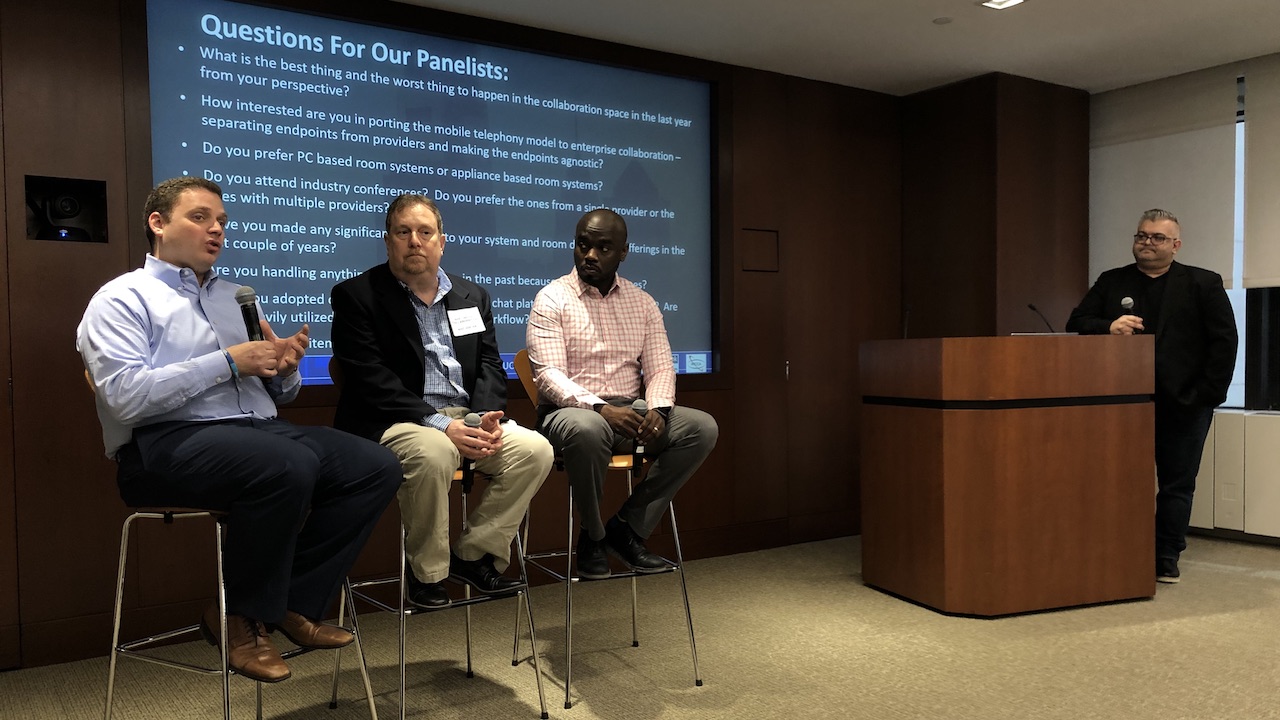3 Takeaways on the State of Collaboration From CWNY’s Kickoff

IMCCA’s Collaboration Week New York 2020 kicked off on Monday morning with an opening session hosted by BlackRock in Midtown. The program began with an overview presentation by David Danto, director of emerging technologies at the IMCCA, followed by a panel featuring end users in the financial sector, and finished with a presentation on data and analytics by Vyopta.
[IMCCA Wraps Collaboration Week Silicon Valley]
The following are some of the key issues covered in the morning’s program.
1. Unified Communications Isn’t Unified
The costs of videoconferencing and collaboration systems have plummeted, and their quality and reliability has risen—sounds like a perfect world, right? The problem is, there are a number of platforms and they don’t always interoperate.
“We’re in this whole era of ‘coopetition,’” Danto said. “Standards helped solve that, at least for the last 10 or 12 years, but the joke is it’s always correct in the first person: ‘Our standards are good; their standards are wrong.’ There are too many people fighting over the standards and the licensing and everything else.”
Danto went on to say that there are periods where “everyone is singing Kumbaya,” pointing to the recent news that Microsoft Teams, Zoom, and Cisco have announced a plan to work together to allow for interoperability. “It’s not working yet, we’re not sure when it’s going to work, and if they actually do get it to work (which I’m sure they will), the first person that makes a software change to one of the systems is probably going to break it again. But this is something that’s going to change and the change is happening in the industry right now.”
2. Work Habits are Shifting
As collaboration tech improves, the need for workers to be physically present in the office is diminishing. Couple that with expectations from Millennial and Generation Z workers, and remote work is exploding.
A daily selection of features, industry news, and analysis for AV/IT professionals. Sign up below.
Due to this, tech managers are being forced to foster a mobile-first culture, which has inherent issues—with security a leading concern. “I think mobile is going to grow significantly over the next few years,” said Gary Anselme, engineering director of global infrastructure at American Express. “At the table, when you’re thinking about mobile first, security should be there with you along with your general counsel, just because you want to make sure you’re not putting your organization at risk in any way.”
And it’s not just mobile devices themselves that pose security risks; managers must also consider the accessories that workers use with them. “The peripheral battle is definitely taking off,” said John Hoyt, director of global multimedia projects and implementation at BlackRock. “What people aren’t looking at is the security vulnerabilities of those Bluetooth headsets: how many people are sitting outside my street in vans, [listening in on] ‘What’s BlackRock doing next?’ Because that’s a real thing.”
“Even worse, you see people using Apple AirPods who have one in one ear and leave the other one at their desk, and they don’t know if anybody picks that up,” Danto added.
In the coming years, expect connectivity technologies like 5G cellular and Wi-Fi 6 to further spur the growth in mobile work.
3. Workplaces Are Evolving Intelligently
The shift to a more dispersed workforce and the mobile-first technology focus have influenced the way offices are being designed—and the availability of data garnered from AV equipment in rooms is enabling further refinement to the maximization of companies’ precious real estate.
“Traditionally, a lot of [workspace] decisions were made by corporate realty,” said Marc Cooper of Citi. “Corporate realty is now more willing to partner with technologists because they understand the value of the metrics. In an open workspace like we’re building a lot of now, there’s a formula that we’re using: so many people on the floor, so many huddle rooms, and so many conference rooms.”
Using people counting from conferencing cameras, organizations are able to improve upon these formulas more intelligently than ever before. “What we’re seeing in the data, anywhere between 40 and 50 percent of [a company’s] scheduled minutes of a room, people aren’t there,” said Nick Wiik, senior product manager at Vyopta. “They’re looking at the calendar, they’re looking at what’s available, and we know that there’s a big difference between what is booked and what is actually used.”
This goes further than just space utilization, enabling organizations to know just what technology needs to be in a space. “Not everyone needs to be collaborating all the time,” Cooper said. “I have a lot of work that I have to do that’s personal work, and I need personal space for that. So while I think that collaboration is important, I think it’s also important to recognize the other side of that.”
Ultimately, the best approach is to combine utilization data with subjective insights to find out exactly what people need and prefer. “Sit down with your colleagues and peers, send out surveys to understand what is successful,” Anselme said. “What went well? What didn’t go well? These are questions you should be asking. And be ready for the feedback and try not to be defensive if you hear something negative.”
“Be accepting of feedback,” Hoyt agreed. “Feedback is the most important thing. Good or bad, it’s free information on where you failed, where you did well, and how you can do better next time.”
More from CWNY 2020:
Experts Talk the Evolution of Cloud-Based UC at CWNY
IMCCA Honors Randy Klein, Eric Yuan With Lifetime Achievement Awards
Matt Pruznick is the former editor of AV Technology, and senior editor for Systems Contractor News and Residential Systems. He is based in New York.

